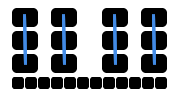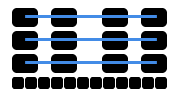Navigating this Webtext
 For the authors of this webtext, one of the opportunities of “the new work of composing” is the potential for digital media and information systems to provide scholars with new research methods, forms of analysis, and means of presenting their arguments. In new media scholarship, the structure and the design of a work can be made to “perform” the argument, allowing writers to explore the potential of networked, non-linear arguments and collaborative methodologies. Lines of inquiry can be staged to underscore productive dissonance or contradiction as crucial elements in intellectual discourse and exploration. And, central to our preoccupations here, these developments all have the potential to bear critically on the received standards and readymade forms that have developed in conventional print scholarship. “Standards in the Making: composing with metadata in mind” is a collaboratively-composed webtext which attempts to take advantage of these opportunities, theorizing a critical approach to new media, web-authoring platforms, and digital information systems in the conceptual space produced between the text’s analysis and its design—between the ideas themselves and how they “move.”
For the authors of this webtext, one of the opportunities of “the new work of composing” is the potential for digital media and information systems to provide scholars with new research methods, forms of analysis, and means of presenting their arguments. In new media scholarship, the structure and the design of a work can be made to “perform” the argument, allowing writers to explore the potential of networked, non-linear arguments and collaborative methodologies. Lines of inquiry can be staged to underscore productive dissonance or contradiction as crucial elements in intellectual discourse and exploration. And, central to our preoccupations here, these developments all have the potential to bear critically on the received standards and readymade forms that have developed in conventional print scholarship. “Standards in the Making: composing with metadata in mind” is a collaboratively-composed webtext which attempts to take advantage of these opportunities, theorizing a critical approach to new media, web-authoring platforms, and digital information systems in the conceptual space produced between the text’s analysis and its design—between the ideas themselves and how they “move.”
Our goal was to make our “Standards in the Making” approach manifest at the level of the chapter’s presentation and navigation—to make the form of the argument itself a tool for observing the concept in action. Part of the critical method of SITM calls for laying bare the process of standardization, which we have staged in the design as four “Layers”, each of which represents a different moment in the development of the argument. Some Layers consist of entries produced individually by one of the four authors of this work and others are collectively-composed. Though this general framework, the chapter explores and synthesizes four different critical assessments of folksonomies and digital information systems in order to see “what standards emerge” for composing (as well as researching and producing scholarship) with metadata in mind.
This design affords a number of options for entering and navigating the arguments contained within. Each entry-point situates you in a different perspective and set of critical preoccupations, and each conclusion maintains traces of the varied and often conflicting set of analyses which were its condition of emergence. There are a number of ways in and a number of ways out, and how you read certainly matters for how these arguments are experienced. What follows is a breakdown of the design of the piece, intended to provide users with some guidelines for situating oneself within the general movements of the work and for navigating its arguments.
Navigating the Text
The chapter is organized into the aforementioned “Layers”: Introduction, Analysis, Synthesis, Standardization. While we invite users to break the linearity of the text and ‘jump layers’, we also note that each layer reached while scrolling down the page builds upon the previous layers. “Standardization” emerges out of “Synthesis”, out of “Analysis”, out of “Introduction”. Each layer also contains a “Method” entry which lays out the tasks or questions which loosely organize the entries contained within while situating them in relation to the other layers. We recommend that you refer to these entries in order to understand the centralizing impulses of each layer of the argument’s development.
 The first three layers (Introduction, Analysis, Synthesis) are composed individually and reflect the field-oriented investments and particular insights of each of the text’s authors. Thus, one option for navigating this webtext is to move vertically up or down the columns that are created by the first three layers. By reading all of entries composed by a single author, you can trace the questions or problematics which emerge from a particular field-oriented perspective. You could, for example, trace Matthew W. Wilson’s entries down the left side of the piece to examine how a GIScience approach confronts the problem of standards in digital tagging systems through a particular set of terms and methodological concerns. From a Digital Humanities perspective, Jentery Sayers’ responses to the same archive are substantively different—posing problematics and readings which emerge from a different set of methods and disciplinary motivations.
The first three layers (Introduction, Analysis, Synthesis) are composed individually and reflect the field-oriented investments and particular insights of each of the text’s authors. Thus, one option for navigating this webtext is to move vertically up or down the columns that are created by the first three layers. By reading all of entries composed by a single author, you can trace the questions or problematics which emerge from a particular field-oriented perspective. You could, for example, trace Matthew W. Wilson’s entries down the left side of the piece to examine how a GIScience approach confronts the problem of standards in digital tagging systems through a particular set of terms and methodological concerns. From a Digital Humanities perspective, Jentery Sayers’ responses to the same archive are substantively different—posing problematics and readings which emerge from a different set of methods and disciplinary motivations.
 Conversely, reading across the layers themselves allows you to juxtapose these field-based perspectives as they each do their own work at a similar stage of the project. This navigation strategy foregrounds the differences between our approaches, allowing you to observe as shared objects and questions produce overlapping or conflicting individual responses. Reading across the “Analysis” layer, for instance, will allow you to see how each author isolates different issues and produces a different set of insights from a reading of the Flickr Commons Project, while reading across the “Synthesis” layer will allow you to compare four different perspectives on the practice of SITM. Since each layer represents a different stage of the argument, the “Method” entries in each are a good way to situate yourself within the objectives of each layer.
Conversely, reading across the layers themselves allows you to juxtapose these field-based perspectives as they each do their own work at a similar stage of the project. This navigation strategy foregrounds the differences between our approaches, allowing you to observe as shared objects and questions produce overlapping or conflicting individual responses. Reading across the “Analysis” layer, for instance, will allow you to see how each author isolates different issues and produces a different set of insights from a reading of the Flickr Commons Project, while reading across the “Synthesis” layer will allow you to compare four different perspectives on the practice of SITM. Since each layer represents a different stage of the argument, the “Method” entries in each are a good way to situate yourself within the objectives of each layer.
We chose to link between these various “layers” by anchoring those links with verbs in an effort to “animate” the text; making it possible to “move” across and through the various ideas and perspectives presented in the chapter.
Our individual trajectories are compiled in the last layer, “Standardization”, which is collectively-authored. Here, you will find 11 entries, each of which assembles the insights of the previous individual work in order to explore a different, emergent “standard” for understanding metadata and web-composition. These entries, therefore, are a point of arrival for the argument – a series of conclusions which consider opportunities and ramifications of an SITM approach from a variety of angles and critical scales. But they are also, perhaps, a starting point for the reader. Each entry in this layer follows from keywords that we feel reflect the convergences emerging from our individual disciplinary perspectives; this is why we chose to anchor links to each entry in the “Standardization” layer to the keywords, themselves, when they appear in the other layers. While each entry represents a facet of the SITM approach which has emerged from our collective engagement, they also each retain traces of the process—citations and staged conversations which can lead users back into the argument to potentially explore different conclusions.
These comments are intended to help users to situate themselves within the argument, not to prohibit or circumvent the potential for exploration. Our hope is that this breakdown provides a conceptual map and set of directional guidelines which readers can use to create their own independent trajectories through the piece, according to the topics and methods which engage them.